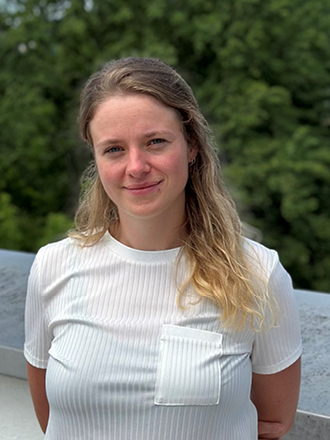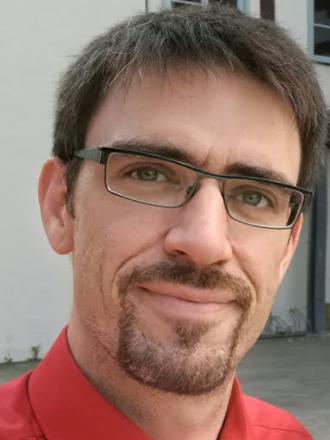Nanotechnology
Nanotechnology
Thursday, September 21st, 2023, at 1:30 pm
Chairs: Ulrike Taylor and Wolfgang Fritzsche
The session deals with Extracellular Vesicles (EVs) and their characterization, with a special focus on exosomes. Exosomes are extracellular vesicles of 30-200 nm size generated by all cells, carrying nucleic acids, proteins, lipids, and metabolites. In the framework of liquid biopsy approaches, they are being investigated for their exploitation in early cancer detection, monitoring of disease progression and chemotherapeutic response, and development of novel targeted therapeutics.

Overview of current methods for the characterization of extracellular vesicles with a focus on single vesicle imaging and quantification
Affiliation
Chemical Biology and Biological Therapeutics, Department of Biosciences and Medical Biology, University of Salzburg, Austria
Abstract
Extracellular vesicles (EV) are nanosized biomolecules involved in cell- to – cell communication which are released by virtually all cells. Within the last decade they gained substantial interest due to their potential use as therapeutics, drug delivery system or biomarker. A big challenge in the field however is the intrinsic heterogeneity and complexity of EVs. To address this, different technologies including NTA (Nanoparticle tracking analysis), TRPS (tunable Resistive Pulse Sensing), DLS (Dynamic Light scattering), FCM (Flow cytometry measurement) and EM (electron microscopy) are commonly used to characterize extracellular vesicles. With the growth of the fields also more and more additional nano- specialized technologies including Nano-FCMs, FCS (fluorescence correlation spectroscopy) and imaging after capture on chips or on biofluids are emerging. All these technologies generally require dedicated instrumentation, expensive consumables and/or proprietary software not readily accessible to every lab, limiting their implementation for routine EV characterization in the rapidly growing EV field. In our group we focus on the development and establishment of robust, simple and low cost protocols for the capture, characterization (immune- labelling, validation of staining, validation and quantification of vesicle loading) and quantification of EVs at the single vesicle level. Additionally, we developed EVAnalyzer as an open source / open access plugin for easy, fast and automated quantification and gating of the vesicles from imaging data. EVAnalyzer can further be used for automated quantification of cell uptake at the single cell – single vesicle level, thereby enabling high content EV cell uptake assays and plate- based screens. Additionally, we will show how the program can be used for the in situ quantification of EVs in tissues as well as serum for applications investigating the biodistribution and pharmacokinetics of EVs in rodent or NHP in vivo models.
Biosketch
Melanie completed her PhD in the lab of Peter Eckl focusing on oxidative stress in the liver. She then moved to the lab of Nicole Meisner-Kober where she works within the EVTT center, an inter-institutional translational research center for Extracellular Vesicle (EV) based theralytic technologies between the Paris-Lodron university Salzburg, the Paracelsus Medical University Salzburg as well as the University Clinics Salzburg. A particular interest of the lab is the discovery and development of EV based therapeutics and drug delivery applications. In this context, the lab is also developing advanced imaging-based technologies for single vesicle characterization and quantification in different in vitro and in vivo models.

Comparing Apples to Apples: Analysis of Extracellular Vesicles by Flow Cytometry
Affiliation
Karolinska Institutet | Department of Laboratory Medicine
Division of Biomolecular and Cellular Medicine (BCM/MCG/BMM)
Stockholm, Sweden
Abstract
Extracellular vesicles (EVs) including exosomes and microvesicles are submicrometer-sized biological vesicles released by all cells, and can be found in all body fluids or harvested from cell culture supernatants. It is nowadays widely accepted that EVs can serve as vesicular messengers in various physiological and pathophysiological contexts. Over the last 10–15 years, the EV research community has grown exponentially and the field has attracted a lot of attention following numerous studies connecting EVs to therapeutic approaches such as vaccination, antitumor therapy, immunomodulation and drug delivery. Since the protein composition and cargo of EVs is assumed to resemble the cell releasing them, EVs also have come into focus as potential diagnostic biomarkers.
Due to their heterogenous nature and their small diameter (<200 nm), it is challenging to accurately measure individual EVs, and to quantify basic parameters such as diameter, size, and concentration of EVs in a sample of interest. In this context, flow cytometry is increasingly used to detect, quantify and phenotype EVs, and newer high-sensitivity flow cytometers have become available and are explored to measure EVs. Current challenges, however, comprise sensitivity, standardization (despite general lack of appropriate standards) and comparability of obtained data. I will give an introduction into possibilities and share examples and experiences in context of EV analysis by flow cytometry in various contexts.
Biosketch
André Görgens obtained his PhD in Hematopoiesis & Stem Cell Biology at the University Hospital Düsseldorf in the lab of Bernd Giebel. He then joined the lab of Samir El Andaloussi at Karolinska Institutet in Stockholm (Sweden) to study Extracellular Vesicles and their role in intercellular communication and to set up, develop and optimize various methods around EV production, preparation, engineering/loading, stability, and analytics.
Martin Hussels
Imaging of Scattered Light in a Flow Cytometer to Analyse Size, Shape and Internal Structures of Particles and Cells
Physikalisch-Technische Bundesanstalt (PTB), Berlin, Germany
Imaging flow cytometry combines the high information content of microscopic images with the high throughput of flow cytometry. In contrast to conventional imaging flow cytometers which – like a microscope – optically process the light coming from cells or particles into real-space images (brightfield or fluorescence), our home-built instrument records the angular intensity distribution of the scattered light of single cells and particles in the far field with fast cameras.
We investigated beads of different materials, synthetic dumbbell particles, as well as cells and bacteria from culture. We have compared measured scatter images with simulations of light scattering and have explored the possibilities for image analysis for the various cases. For spherical particles we used Lorenz-Mie theory to model the far-field intensity to determine the diameter and refractive index of single particles.
For more complex, non-spherical objects, we have performed light scattering calculations using the discrete dipole approximation (DDA). Since cells and bacteria are much more complex and variable than synthetic particles, we compared simulations by simple modelling approaches with measurements to understand the impact of shape and internal structure on light scattering.
In conclusion, the recorded angular intensity distributions contain substantial information about the size, shape, refractive index, and possible internal structures of the scatterers.
Michael Kirschbaum
High-resolution image-activated cell sorting at low shear stress
Fraunhofer Institute for Cell Therapy and Immunology IZI, Branch Bioanalytics and Bioprocesses IZI-BB, Potsdam, Germany
Flow cell sorting based on image analysis is a powerful concept that exploits spatially-resolved features in cells to isolate previously inaccessible cell types.
Here, we present a low-complexity microfluidic approach that enables image-activated cell sorting based on high numerical aperture fluorescence microscopy, achieving an unprecedented level of image quality and resolution (i.e. 216 nm).
Unlike previously published systems, we do not constrict the sample flow to align the cells for imaging, but handle them directly via negative dielectrophoresis (DEP). Without the need to constrict (and thus accelerate) the sample flow, we achieve an acceptable volume throughput at significantly lower flow velocities, greatly facilitating image acquisition and data processing and reducing shear stress.
Cells are aligned and centered in the focal plane via DEP electrodes before images of the cells are taken and analyzed for the presence of target cells. DEP electrodes are also used to sort and guide targets to the sample outlet. Using our approach, we sorted thousands of live T cells at sample volume throughputs in the lower µl min-1 range based on subcellular localization of fluorescence signals (e.g., membrane vs. cytosol) and recovered >85% of the target cells analyzed.
Thanks to the simple and robust concept of our protocol, a standard Windows PC is sufficient to operate the whole system, even when more advanced artificial intelligent computing is used for cell classification.
